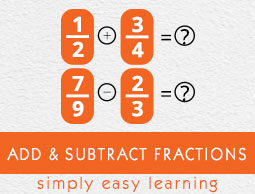
- Add and Subtract Fractions
- Home
- Add or Subtract Fractions With the Same Denominator
- Add or Subtract Fractions With the Same Denominator and Simplification
- Finding the LCD of Two Fractions
- Addition or Subtraction of Unit Fractions
- Addition or Subtraction of Fractions With Different Denominators
- Add or Subtract Fractions With Different Denominators Advanced
- Word Problem Involving Add or Subtract Fractions With Different Denominators
- Fractional Part of a Circle
Finding the LCD of Two Fractions
Definition
When we add or subtract fractions, their denominators need to be same or common. If they are different, we need to find the LCD (least common denominator) of the fractions before we add or subtract.
To find the LCD of the fractions, we find the least common multiple (LCM) of their denominators. LCD can be found by two methods. In the first method, LCD of two or more fractions is found as the smallest of all the possible common denominators.In second method, we find the prime factors of the denominators. Then we look for the most occurrence of each of those prime factors and then take their product. This gives the LCD of the fractions.
Formula 1
Here is how to find out LCD of any two fractions; for example 1/3 and 1/6:
Their denominators are 3 and 6 and the multiples of 3 and 6 are
List the multiples of 3: 3, 6, 9, 12, 15, 18, 21, ...
List the multiples of 6: 6, 12, 18, 24, ...
The common multiples are 6, 12, 18...The least among these common multiples is 6. So, 6 is the Least Common Denominator of 1/3 and 1/6.
Formula 2
Here is how to find out LCD of any two fractions; for example 1/8 and 7/12:
The denominators of the fractions are 8 and 12
Their prime factorizations are
8 = 2 2 2
12 = 2 2 3
The most occurrences of the primes 2 and 3 are 2 2 2 (in 8) and 3 (in 12).
Their product is 2 2 2 3 = 24
So, 24 is the LCD of these two fractions.
Problem 1
Find the LCD of $\frac{3}{8}$, $\frac{5}{12}$
Solution
Step 1:
Since the denominators of the fractions are different, we need to find the LCD of the fractions.
The denominators of the fractions are 8 and 12.
Step 2:
To find their LCD, we find their multiples
8: 8, 16, 24, 32, 40, 48...
12: 12, 24, 36, 48,....
Step 3:
The common multiples of 8 and 12 are 24, 48....
Step 4:
The least of the common multiples is 24. So, 24 is the LCD of these two fractions.
Problem 2
Find the LCD of $\frac{3}{4}$, $\frac{7}{9}$
Solution
Step 1:
Since the denominators of the fractions are different, we need to find the LCD of the fractions.
The denominators of the fractions are 4 and 9.
Step 2:
To find their LCD, we find their prime factorization.
4 = 2 2
9 = 3 3
Step 3:
The most occurrences of the primes 2 and 3 are 2 2 (in 4) and 3 3 (in 9). Their product is 2 2 3 3 = 36
Step 4:
So 36 is the LCD of these two fractions.